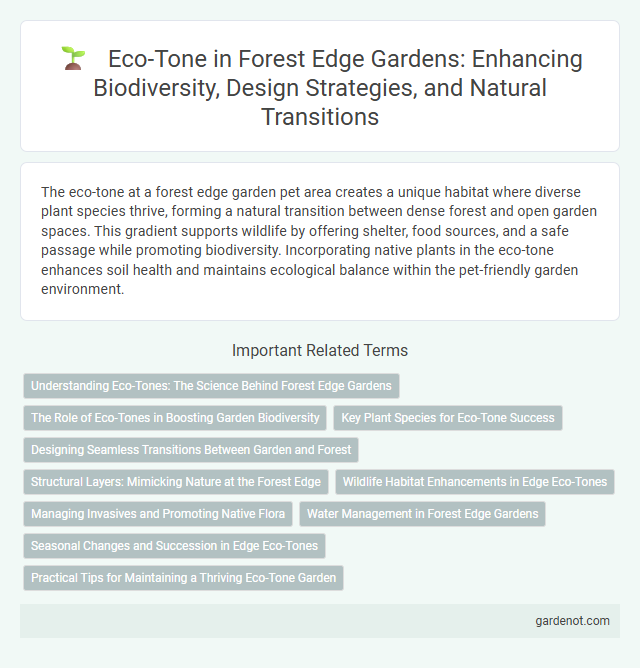The eco-tone at a forest edge garden pet area creates a unique habitat where diverse plant species thrive, forming a natural transition between dense forest and open garden spaces. This gradient supports wildlife by offering shelter, food sources, and a safe passage while promoting biodiversity. Incorporating native plants in the eco-tone enhances soil health and maintains ecological balance within the pet-friendly garden environment.
Understanding Eco-Tones: The Science Behind Forest Edge Gardens
Eco-tones represent transition zones where two distinct ecosystems, such as forests and grasslands, converge, creating diverse habitats with high biological productivity and species richness. Forest edge gardens utilize these eco-tones by mimicking natural boundaries, enhancing biodiversity, and promoting ecological interactions between plants, animals, and microorganisms. This strategic placement increases resource availability like sunlight and nutrients, facilitating resilient and sustainable garden ecosystems.
The Role of Eco-Tones in Boosting Garden Biodiversity
Eco-tones in forest edge gardens serve as transitional zones that enhance plant diversity and provide critical habitats for pollinators and wildlife, increasing overall garden biodiversity. These areas promote ecological connectivity by linking different habitats, which supports species movement and nutrient cycling essential for healthy ecosystems. Incorporating native plants in eco-tones further stabilizes soil and encourages beneficial insect populations, making forest edge gardens more resilient and sustainable.
Key Plant Species for Eco-Tone Success
Key plant species such as native grasses, shrubs like Ceanothus and Manzanita, and trees including oaks and pines play a crucial role in establishing a successful eco-tone at forest edges. These species provide essential habitat connectivity, promote biodiversity, and facilitate natural succession processes. Incorporating a diverse mix of drought-tolerant and shade-adapted plants enhances soil stability and supports wildlife ecological functions in forest edge gardens.
Designing Seamless Transitions Between Garden and Forest
Eco-tone design emphasizes creating seamless transitions between garden spaces and adjacent forests by integrating native plants that thrive in both environments. Utilizing gradient planting techniques and variations in plant height and texture helps mimic natural edge conditions, promoting biodiversity and ecological connectivity. Such designs support wildlife corridors and enhance resilience against environmental changes, fostering a harmonious blend between cultivated gardens and wild forest areas.
Structural Layers: Mimicking Nature at the Forest Edge
Eco-tone structural layers in a forest edge garden replicate natural transitions by incorporating canopy, understory, shrub, and groundcover strata. This layered vegetation supports diverse ecosystems, promoting biodiversity and enhancing habitat connectivity. Mimicking these vertical and horizontal structures optimizes microclimates and resource use efficiency within the garden.
Wildlife Habitat Enhancements in Edge Eco-Tones
Edge eco-tones create critical wildlife habitat enhancements by providing diverse plant species that support native fauna. These transitional zones between forest and open land increase biodiversity by offering food, shelter, and nesting sites for birds, insects, and small mammals. Incorporating native shrubs and grasses in forest edge gardens strengthens ecological connectivity and promotes sustainable wildlife populations.
Managing Invasives and Promoting Native Flora
Eco-tones at forest edge gardens serve as critical buffers that support biodiversity by managing invasive species and promoting native flora growth. Implementing targeted invasive species control techniques reduces competition and habitat disruption, allowing native plants such as oaks, maples, and wildflowers to thrive. Enhancing native vegetation strengthens ecosystem resilience, improves wildlife habitat quality, and maintains ecological balance within these transition zones.
Water Management in Forest Edge Gardens
Eco-tones in forest edge gardens play a critical role in water management by acting as natural buffers that slow runoff and enhance water infiltration into the soil. These transition zones support diverse vegetation that stabilizes soil, reduces erosion, and filters pollutants, promoting healthier groundwater recharge. Integrating eco-tones optimizes hydrological cycles and sustains moisture levels essential for both forest and garden ecosystems.
Seasonal Changes and Succession in Edge Eco-Tones
Eco-tones at the forest edge garden exhibit distinct patterns of seasonal changes and ecological succession, where diverse plant species adapt to varying light, moisture, and temperature conditions. Succession processes shape the structure and composition of edge habitats by gradually transitioning from herbaceous plants to shrubs and eventually mature forest species. These dynamic shifts enhance biodiversity and ecosystem productivity by creating unique microhabitats within the edge environment.
Practical Tips for Maintaining a Thriving Eco-Tone Garden
Maintaining a thriving eco-tone garden requires selecting native plants that thrive at the boundary between forest and open land, enhancing biodiversity by attracting local wildlife and pollinators. Regularly monitor soil moisture levels and use organic mulches to retain water and suppress weeds, ensuring healthy root systems and nutrient availability. Implement companion planting strategies and avoid synthetic chemicals to promote natural pest control and sustain the delicate balance of the eco-tone ecosystem.
Eco-tone Infographic

 gardenot.com
gardenot.com